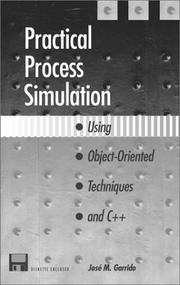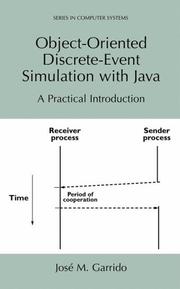| Listing 1 - 7 of 7 |
Sort by
|
Book
ISBN: 8814069719 9788814069710 Year: 1998 Publisher: Milano : Giuffrè Editore,
Abstract | Keywords | Export | Availability | Bookmark
 Loading...
Loading...Choose an application
- Reference Manager
- EndNote
- RefWorks (Direct export to RefWorks)
Book
ISBN: 1441955003 1441905154 9786612363870 1282363875 1441905162 9781441955005 Year: 2010 Publisher: New York: Springer,
Abstract | Keywords | Export | Availability | Bookmark
 Loading...
Loading...Choose an application
- Reference Manager
- EndNote
- RefWorks (Direct export to RefWorks)
Object Oriented Simulation José Garrido About this textbook: Object Oriented Simulation will qualify as a valuable resource to students and accomplished professionals and researchers alike, as it provides an extensive, yet comprehensible introduction to the basic principles of object-oriented modeling, design and implementation of simulation models. Key features include an introduction to modern commercial graphical simulation and animation software, accessible breakdown of OOSimL language constructs through various programming principles, and extensive tutorial materials ideal for undergraduate classroom use. Presents a comprehensive introduction to the basic principles of object-oriented modeling, design, and implementation of simulation models. Encourages a stronger foundation with objects and classes using an "objects early" approach. Emphasizes model implementation with minimal treatment of statistics. Accommodates a smooth transition to object-oriented modeling and a gradual introduction to object-oriented simulation for professionals. Provides complete case studies fully explained with corresponding case study in OOSimL. Includes summaries, examples, and problems in every chapter. Simulation software presented in material is available on the book’s web site. Introduces graphical simulation and animation software Arena and Flexsim. Models described with UML and/or extended simulation diagrams. .
Computer simulation. --- Object-oriented methods (Computer science). --- Object-oriented programming (Computer science). --- Object-oriented programming (Computer science) --- Object-oriented methods (Computer science) --- Computer simulation --- Engineering & Applied Sciences --- Computer Science --- Object development methods (Computer science) --- Object orientation (Computer science) --- Object-oriented development (Computer science) --- Object technology (Computer science) --- Computer modeling --- Computer models --- Modeling, Computer --- Models, Computer --- Simulation, Computer --- Computer science. --- Computer programming. --- Computers. --- Computer Science. --- Programming Techniques. --- Simulation and Modeling. --- Models and Principles. --- Electromechanical analogies --- Mathematical models --- Simulation methods --- Model-integrated computing --- Computer programming --- Document Object Model (Web site development technology) --- System design --- Informatics --- Science --- Automatic computers --- Automatic data processors --- Computer hardware --- Computing machines (Computers) --- Electronic brains --- Electronic calculating-machines --- Electronic computers --- Hardware, Computer --- Computer systems --- Cybernetics --- Machine theory --- Calculators --- Cyberspace --- Computers --- Electronic computer programming --- Electronic data processing --- Electronic digital computers --- Programming (Electronic computers) --- Coding theory --- Programming

ISBN: 0890066558 Year: 1999 Publisher: Boston, MA : Artech house,
Abstract | Keywords | Export | Availability | Bookmark
 Loading...
Loading...Choose an application
- Reference Manager
- EndNote
- RefWorks (Direct export to RefWorks)
C++ (Computer program language) --- Computer simulation --- Object-oriented methods (Computer science) --- Object development methods (Computer science) --- Object orientation (Computer science) --- Object-oriented development (Computer science) --- Object technology (Computer science) --- System design --- Computer modeling --- Computer models --- Modeling, Computer --- Models, Computer --- Simulation, Computer --- Electromechanical analogies --- Mathematical models --- Simulation methods --- Model-integrated computing --- Contains audio-visual material --- Problems, exercices

ISBN: 0306464594 9786610205516 1280205512 0306469766 9780306464591 Year: 2000 Publisher: New York [N.Y.]: Kluwer academic/Plenum,
Abstract | Keywords | Export | Availability | Bookmark
 Loading...
Loading...Choose an application
- Reference Manager
- EndNote
- RefWorks (Direct export to RefWorks)
This book introduces the fundamental concepts and practical simulation te- niques for modeling different aspects of operating systems to study their g- eral behavior and their performance. The approaches applied are obje- oriented modeling and process interaction approach to discrete-event simu- tion. The book depends on the basic modeling concepts and is more specialized than my previous book: Practical Process Simulation with Object-Oriented Techniques and C++, published by Artech House, Boston 1999. For a more detailed description see the Web location: http://science.kennesaw.edu/~jgarrido/mybook,html. Most other books on performance modeling use only analytical approaches, and very few apply these concepts to the study of operating systems. Thus, the unique feature of the book is that it concentrates on design aspects of operating systems using practical simulation techniques. In addition, the book illustrates the dynamic behavior of different aspects of operating systems using the various simulation models, with a general hands-on approach.
Operating systems (Computers) --- Object-oriented methods (Computer science) --- Evaluation --- 681.3*D15 --- -Object development methods (Computer science) --- Object orientation (Computer science) --- Object-oriented development (Computer science) --- Object technology (Computer science) --- 681.3*D15 Software: object-oriented programming --- Software: object-oriented programming --- Computer operating systems --- Computers --- Disk operating systems --- Operating systems --- Operating systems (Computers) -- Evaluation. --- Computer science. --- Computer organization. --- Microprocessors. --- Programming languages (Electronic computers). --- Operating systems (Computers). --- System theory. --- Computer Science. --- Programming Languages, Compilers, Interpreters. --- Operating Systems. --- Processor Architectures. --- Computer Systems Organization and Communication Networks. --- Systems Theory, Control. --- Object development methods (Computer science) --- System design --- Systems software --- Evaluation. --- Computer network architectures. --- Systems theory. --- Systems, Theory of --- Systems science --- Science --- Organization, Computer --- Electronic digital computers --- Minicomputers --- Computer languages --- Computer program languages --- Computer programming languages --- Machine language --- Electronic data processing --- Languages, Artificial --- Philosophy --- Simulation methods. --- Operating systems (Computers) - Evaluation

ISBN: 0306466880 1461354951 1461513197 Year: 2001 Publisher: New York, N.Y. Kluwer Academic/ Plenum Publishers
Abstract | Keywords | Export | Availability | Bookmark
 Loading...
Loading...Choose an application
- Reference Manager
- EndNote
- RefWorks (Direct export to RefWorks)
Researches and developers of simulation models state that the Java program ming language presents a unique and significant opportunity for important changes in the way we develop simulation models today. The most important characteristics of the Java language that are advantageous for simulation are its multi-threading capabilities, its facilities for executing programs across the Web, and its graphics facilities. It is feasible to develop compatible and reusable simulation components that will facilitate the construction of newer and more complex models. This is possible with Java development environments. Another important trend that begun very recently is web-based simulation, i.e., and the execution of simulation models using Internet browser software. This book introduces the application of the Java programming language in discrete-event simulation. In addition, the fundamental concepts and prac tical simulation techniques for modeling different types of systems to study their general behavior and their performance are introduced. The approaches applied are the process interaction approach to discrete-event simulation and object-oriented modeling. Java is used as the implementation language and UML as the modeling language. The first offers several advantages compared to C++, the most important being: thread handling, graphical user interfaces (QUI) and Web computing. The second language, UML (Unified Modeling Language) is the standard notation used today for modeling systems as a collection of classes, class relationships, objects, and object behavior.
Programming --- Computer programming. --- Software engineering. --- Computer simulation. --- System theory. --- Programming languages (Electronic computers). --- Mathematical models. --- Programming Techniques. --- Software Engineering. --- Simulation and Modeling. --- Systems Theory, Control. --- Programming Languages, Compilers, Interpreters. --- Mathematical Modeling and Industrial Mathematics. --- Models, Mathematical --- Simulation methods --- Computer languages --- Computer program languages --- Computer programming languages --- Machine language --- Electronic data processing --- Languages, Artificial --- Systems, Theory of --- Systems science --- Science --- Computer modeling --- Computer models --- Modeling, Computer --- Models, Computer --- Simulation, Computer --- Electromechanical analogies --- Mathematical models --- Model-integrated computing --- Computer software engineering --- Engineering --- Computers --- Electronic computer programming --- Electronic digital computers --- Programming (Electronic computers) --- Coding theory --- Philosophy
Digital
ISBN: 9781441905161 Year: 2009 Publisher: Boston, MA Springer-Verlag US
Abstract | Keywords | Export | Availability | Bookmark
 Loading...
Loading...Choose an application
- Reference Manager
- EndNote
- RefWorks (Direct export to RefWorks)
Computer science --- Programming --- Artificial intelligence. Robotics. Simulation. Graphics --- vormgeving --- informatica --- simulaties --- programmeren (informatica)
Book
ISBN: 9781441905161 Year: 2009 Publisher: Boston MA Springer US
Abstract | Keywords | Export | Availability | Bookmark
 Loading...
Loading...Choose an application
- Reference Manager
- EndNote
- RefWorks (Direct export to RefWorks)
Object Oriented Simulation José Garrido About this textbook: Object Oriented Simulation will qualify as a valuable resource to students and accomplished professionals and researchers alike, as it provides an extensive, yet comprehensible introduction to the basic principles of object-oriented modeling, design and implementation of simulation models. Key features include an introduction to modern commercial graphical simulation and animation software, accessible breakdown of OOSimL language constructs through various programming principles, and extensive tutorial materials ideal for undergraduate classroom use. Presents a comprehensive introduction to the basic principles of object-oriented modeling, design, and implementation of simulation models. Encourages a stronger foundation with objects and classes using an "objects early" approach. Emphasizes model implementation with minimal treatment of statistics. Accommodates a smooth transition to object-oriented modeling and a gradual introduction to object-oriented simulation for professionals. Provides complete case studies fully explained with corresponding case study in OOSimL. Includes summaries, examples, and problems in every chapter. Simulation software presented in material is available on the book's web site. Introduces graphical simulation and animation software Arena and Flexsim. Models described with UML and/or extended simulation diagrams.
Computer science --- Programming --- Artificial intelligence. Robotics. Simulation. Graphics --- vormgeving --- informatica --- simulaties --- programmeren (informatica)
| Listing 1 - 7 of 7 |
Sort by
|

 Search
Search Feedback
Feedback About UniCat
About UniCat  Help
Help News
News